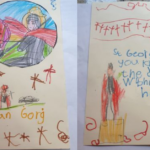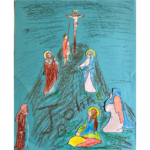
St. Peter Claver was born in 1580, in Verdu, Catalonia, Spain. He was the son of a farmer coming from a rather poor family. However he made his way to be able to study at the University of Barcelona that was run by the Society of Jesus, the Jesuits. In 1602, Peter himself joined the Jesuits and was encouraged by another Jesuit, Alphonse Rodriguez, to do missionary work in the Spanish colonies of America and that is what he did in 1610, journeying to the New Kingdom of central America as a missionary. It was here that he continued his studies for the priesthood and was ordained priest.
By this time, the slave trade had already flourished in Central and South America. Years before, the strong Spanish navy had journeyed to this part of the world, taking possession of vast territories of land. Spanish landowners needed labourers to cultivate the land and work in the goldmines. But the natives of the land were neither enough in number nor strong enough for the strenuous work.
Ships set out to the shores of Africa, along the coasts of Guinea, the Congo and Angola where they kidnapped locals or traded slaves from the king, for a petty sum of money, to be sold at a profit at the Port of Caragena (now Colombia). Each month about a thousand slaves landed there after being held in the hold of the ship and later in warehouses in sordid conditions, to be sold later as slaves to rich landowners.
It was in this infested environment steeped in stench that Peter Claver started his missionary work, dedicating himself to treating the slaves with human dignity, to the extent that he became known as he himself described himself, ‘the slave of the negro slaves’. The word “Negro” was used because of the brown skin colour of the slaves, but soon it also became a word that implied lack of respect, that reflected the horrible actions of “white” slave traders.
In this context, Peter was different for he always respected the dignity of those who were sold in slavery. He would beg and collect clothes, bread, fruit and even medicines and carrying everything in baskets. He would tend to the slaves handing around jugs of water. While doing this to alleviate their sufferings, he told them how Jesus loved each and every one of them. Then he would instruct them into the Faith helped by interpreters and catechists from the mission stationed in the area. If they would become Christians, Peter Claver would continue to administer the Sacraments to them.
Peter Claver’s ministry extended beyond his attention to the slaves. He preached in the city square, in missions to traders snd sailors, travelling to the plantations in the countryside as follow-up to meet the slaves he would have baptized, while seeking new converts, choosing to lodge in the slaves’ quarters for most of the time.
The ministry of Peter Claver stretched over 40 years. It is estimated that he brought 300,000 people who had been sold to slavery to Christianity! For as St Pail says: In Christ there is no slave or free. We are all equal in Jesus’ eyes. St. Peter Claver died in 1654 after 4 years suffering from the plague. He had dedicated his life to the poorest of the poor, those kidnapped and sold to slavery, and he remains known for living the evangelical precept of showing love in deeds and not in words.
(For the older children you might consider taking a world map and trace St. Peter Claver’s journey from Spain to Colombia and trips from Central America to the West Coast of Africa crossing the oceans in ships.












